Are you looking for a new winter coat, or maybe sewing a baby blanket as a special gift? Either way, you may find yourself confused by the plethora of winter fabrics out there. For example, if you consider sherpa vs. fleece, what is the difference between them?
Sherpa fabric resembles sheepskin, with a smooth knit on one side and a fuzzy nap on the other side. Fleece describes any fabric that is brushed on at least one side to create a soft pile. Sherpa fabric is primarily used as a lining, while fleece comes in many thicknesses and can be worn on its own.
Let’s take a look at the distinct characteristics of sherpa and fleece, consider their pros and cons, and determine which fabric best suits your needs.

Sherpa vs Fleece: Key Points
Here’s a quick overview of the key characteristics associated with each of these fabrics. We’ll compare sherpa and fleece in more detail later; this is to give you a general idea of what you can expect from these fabrics!
- Warmth: While it is very warm, sherpa fabric mostly gets used as a lining inside other fabrics. It does a great job trapping heat in its soft, faux-wool nap. Fleece fabric is incredibly warm. Depending on its weight and thickness, it can serve as a coat on its own.
- Thickness: One of the biggest differences between these two materials is their distinct levels of thickness. You can buy fleece in varying weights and thicknesses, from lightweight, slightly scratchy microfleece to thick, blanket-like polar fleece. Sherpa fabric is usually a light knit with a fuzzy velvet pile on the other side and is not particularly thick.
- Softness: This is another discrepancy between the two fabrics. Sherpa fabric is almost always softer than other kinds of fleece.
- Moisture Wicking: Both fabrics are usually made from synthetic material, which provides great moisture-wicking abilities perfect for a coat’s lining.
- Ease of Care: Both fabrics allow for fairly easy care. Though they are both machine washable, you should wash them in cold water and avoid placing them in the dryer.
- Cost: As with anything, the cost depends on what kind of item you plan to buy! Generally, though, you can expect sherpa fabric to cost a bit more than most other kinds of fleece.
- Uses: Whenever you want warmth, look for fleece! This versatile fabric works well in jackets, coats, and blankets. On the other hand, Sherpa fabric will mostly show up as a warm lining inside things like coats and blankets.
| Sherpa Fabric | Fleece | |
| Warmth | As warm as sheepskin, but not used on its own | Very warm, can stand alone as a jacket or coat |
| Thickness | Fairly lightweight | Thickness varies; can be as light as microfleece or as thick and heavy as polar fleece |
| Softness | Very soft, often described as velvety | Can be a little scratchy, and pilling makes it less comfortable after a while |
| Moisture Wicking | Very good | Very good-excellent, depending on the kind of fleece |
| Ease of Care | Fairly easy; cold wash only | Fairly easy; can’t go in the dryer |
| Cost | Much cheaper than real sheepskin, but sometimes pricier than other winter fabrics | Very cheap |
| Uses | Linings in coats, blankets, sweatpants, etc | Coats, blankets, jackets, mittens |
What is Sherpa Fabric?
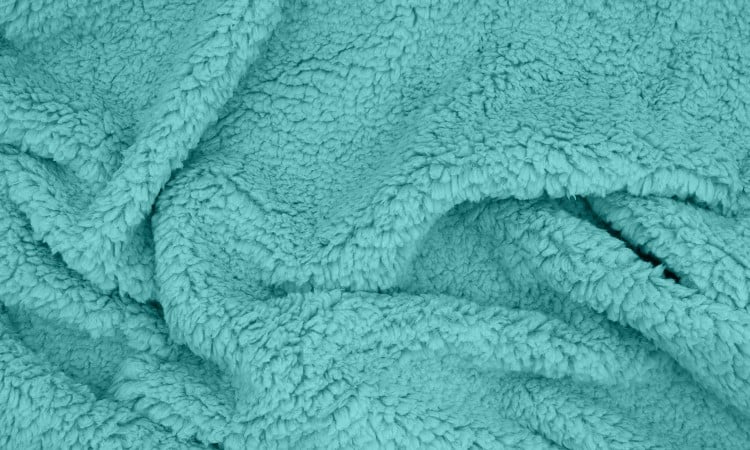
Sherpa fabric is two-sided, with a smooth knit on one side and a soft, silky pile on the other side. Like all fleece fabrics, the nap on its fuzzy side comes from rubbing with a wire brush. However, sherpa gets its distinct wool-like appearance from crimping the loose fibers after the brushing.
Usually made out of polyester, this fabric is synthetic, though it’s meant to look and feel like “shearling,” which is lambskin with the wool still attached. Like many polyester fabrics, it usually has a cozy, slightly stretchy give to it.
You can find sherpa fabric made of cotton or other natural fibers as well, though these options may cost more than the synthetic version.
Originally designed to mimic the sheepskin-lined coats traditionally worn by the Sherpa people, an ethnic group who live in a very cold region of Nepal, sherpa fabric is sometimes also called faux-sheepskin or faux-shearling.
Many people value real sheepskin for its long history of warmth and style in many cultures worldwide. Today, though, many people prefer vegan options for their clothing. Sherpa is a perfect balance, providing the warmth and resemblance to the traditional style without harming any animals.
You can find sherpa fabric as a warm lining in winter coats and gloves, blankets, sweatpants, and (because it is so soft) in baby items like baby blankets and snuggies as well.
Occasionally you may see a coat or jacket made out of sherpa fabric. This provides a distinctly sheepskin-like, cowboy-esque look. Usually, though, this fabric features as a soft, woolly lining inside a garment.
What is Fleece Fabric?
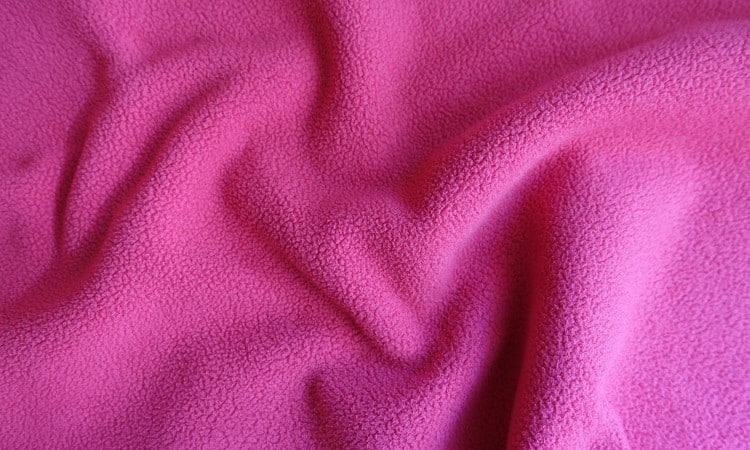
Fleece fabric comes in many different weights and styles. It is characterized by its fluffy nap; all fleece fabrics are brushed on at least one side of the fabric to pull fibers loose from the weave and create a plush, soft pile.
Most fleece fabric is synthetic, made from PET (Polyethylene terephthalate, a kind of polyester). You can also find it made of cotton or even bamboo, though natural fiber fabrics often cost more than synthetics.
Popular versions of this cozy winter fabric include polar fleece, microfleece, lycra-blend fleece, and french terry fleece. Technically, sherpa fabric is also a kind of fleece, though it is usually just called sherpa fabric.
Unlike sherpa, which is primarily used as a lining material, some fleeces like polar fleece are thick enough to wear without additional layers of fabric. You can find fleece in blankets, coats, sweaters, sweatshirts, and mittens–in fact, you can find fleece fabric pretty much in any place where people want to be warm!
What’s the Difference Between Sherpa and Fleece?
The main difference between fleece fabric and sherpa fabric is that sherpa is designed to look like sheepskin and is mostly used as a lining material. On the other hand, Fleece can stand on its own as a jacket or blanket, depending on its weight and thickness. Technically sherpa fabric is a kind of fleece since it has the brushed nap that defines this versatile type of winter fabric.
These comparisons will give you a better idea of what to expect from each kind of fabric.
Warmth
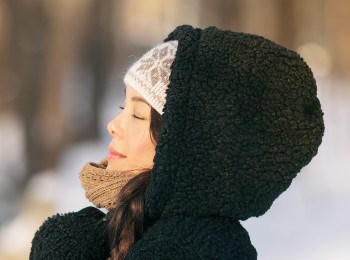 Both kinds of material score very highly for warmth. Any garment made from these fabrics will keep you nice and insulated for sure!
Both kinds of material score very highly for warmth. Any garment made from these fabrics will keep you nice and insulated for sure!
Many people believe that sherpa lining is even warmer than the sheepskin and wool that it imitates!
Some fleeces, like microfleece, also provide a warm lining material. Others, like polar fleece, are warm enough to be worn on their own. All fleeces have a soft, brushed nap on at least one side that traps body heat and provides lots of warmth.
Thickness
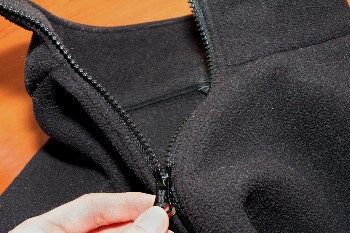 Sherpa fabric falls somewhere between the heft and thickness of an actual sheepskin and the thinness of cotton fabrics. Its knit layer gives it a bit of thickness, but it is a fairly thin and flexible lining material.
Sherpa fabric falls somewhere between the heft and thickness of an actual sheepskin and the thinness of cotton fabrics. Its knit layer gives it a bit of thickness, but it is a fairly thin and flexible lining material.
Fleece fabric comes in a wide range of thicknesses. Technically, fleeces are described in grams per square meter or gsm. Essentially, this means that more weight in a smaller space = a thicker fabric.
For example, a square meter (roughly eleven square feet) of polar fleece will probably weigh about 300 grams, while a square meter of microfleece may weigh as little as 100 grams.
To qualify as microfleece, the fabric must weigh less than 200 grams per square meter, which means it is very lightweight!
However, some polar or thermal fleeces can be up to half an inch thick, so of course, they weigh more and provide extra insulation as well.
Softness
 Generally speaking, sherpa fabric is the softest of the winter fabrics, perhaps even softer than the shearling it resembles. This is why sherpa stars in so many baby items, like baby blankets! The thick, woolly pile of its brushed side feels silky and velvety to the touch.
Generally speaking, sherpa fabric is the softest of the winter fabrics, perhaps even softer than the shearling it resembles. This is why sherpa stars in so many baby items, like baby blankets! The thick, woolly pile of its brushed side feels silky and velvety to the touch.
You will often find sherpa described as “luxurious,” “cozy,” and “super soft.”
The softness of fleece varies a lot. Some fleece fabrics may feel a bit scratchy to the touch, though others, like polar fleece, generally feel pretty soft. All of the variations have that nice, soft pile on at least one side, but sometimes the pile feels more felted than silky.
Some fleeces come in anti-pilling varieties, which help prevent the annoying, scratchy nubs of fabric that form on napped fabrics after a while.
Moisture Wicking
It may seem odd to think about winter fabrics as moisture-wicking–you probably usually think about athletic fabrics like spandex when you consider materials that handle sweat well!
However, most fleeces, including sherpa fabric, are excellent at moisture wicking due to their synthetic fibers. This is another reason they make great linings for winter coats.
Like most synthetic fabrics, both of these winter fabrics work great to repel moisture because of their water-resistant, or hydrophobic, fibers.
Neither fabric will protect you in a deluge, though. The loose, fuzzy pile of fleece means that water can leak through the airgaps in the fabric’s weave. So don’t wear either of these winter fabrics as an outer layer in the rain!
Ease of Care
Both sherpa fabric and most fleeces work well for clothing and blankets because they are easy to clean.
Unlike actual sheepskin, sherpa is washable, though you should use cool water. Fleece is also washable, though you probably shouldn’t put it in the dryer–it can pill very easily, losing its soft, comfortable nap.
Do not iron either of these fabrics. They could melt or scorch quite easily.
Cost
The cost of these fabrics varies greatly, depending on what kind of item you’re buying. The fabric itself is quite affordable because it is usually synthetic. Typically sherpa fabric by the yard might cost around $15, while polar fleece may cost as little as $6.
A sherpa-lined coat will cost much less than an actual sheepskin coat, but it costs a lot more than a polar fleece blankets, which you might find as cheaply as ten dollars. It all depends on what you want to buy!
Uses
As you have already seen, fleece comes in handy for many cozy items like coats, blankets, and sweatshirts.
You’ll find sherpa fabric used for warmth, but mostly only as linings: you can find it lining everything from gloves to dog beds to baby blankets! Sherpa-lined sweatpants might be a good investment for those long work-from-home days as well!
Pros and Cons of Sherpa
Here’s a quick recap for you! Sherpa fabric is:
- A cheaper, vegan fabric designed to look like sheepskin
- Just as warm or warmer than actual wool
- Moisture-wicking because of its synthetic fibers
- A popular lining for blankets, animal beds, and coats
- Typically only used as a lining material
- A bit pricier than most other winter fabrics
Pros and Cons of Fleece
Here’s a quick recap for you! Fleece is:
- Very affordable
- Usually made out of polyester
- Available in a variety of weights and styles
- Used on its own, not just as a lining
- Moisture-wicking because of its synthetic fibers
- Often used in blankets, coats, and jackets
- Not as soft as sherpa fabric
Popular Products Made of Sherpa and Fleece
As two of the most popular winter fabrics on the market, you can find sherpa lining and many different kinds of fleece everywhere you look! Here are a couple of products to give you an idea of the most popular uses of these materials.
Wantdo Women’s Winter Sherpa Lined Parka
 This stylish winter coat comes in various colors and has a sleek, fitted cut to accentuate your waist and hips! An adjustable drawstring at the waist allows you to make the coat either boxier or more fitted, depending on your preference.
This stylish winter coat comes in various colors and has a sleek, fitted cut to accentuate your waist and hips! An adjustable drawstring at the waist allows you to make the coat either boxier or more fitted, depending on your preference.
The sherpa lining, made of all-natural cotton, will keep you super warm as it traps your body heat in its velvety-soft nap. The whole coat features a breathable and warm design. Special touches like the lined cuffs and pockets provide an extra touch of warmth as well.
This coat looks nice enough to wear to the office. Better yet, its easy-to-clean surface and deep warmth make it rugged enough for outdoor fun like hiking or camping.
Worried about cleaning up after an outdoor excursion? This winter coat is machine washable!
Columbia Fleece Jacket
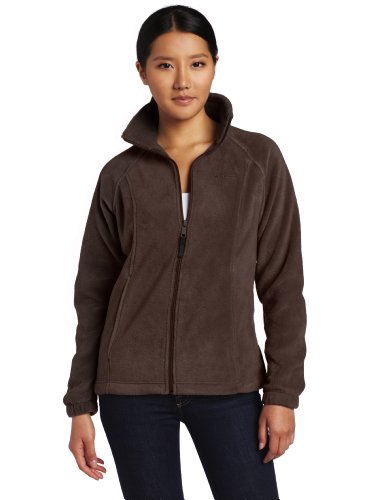 Available in a whopping 40 different colors, this fuzzy, affordable Columbia Fleece Jacket will keep you warm at home or on a walk around your neighborhood! Made of 100% polyester, the synthetic fabric will also keep you comfortable on a morning jog because of its moisture-wicking ability.
Available in a whopping 40 different colors, this fuzzy, affordable Columbia Fleece Jacket will keep you warm at home or on a walk around your neighborhood! Made of 100% polyester, the synthetic fabric will also keep you comfortable on a morning jog because of its moisture-wicking ability.
The jacket has a high zippered collar for chilly temperatures and pockets that zip up for a bit of extra security.
While you can wear this jacket alone quite comfortably in chilly weather, you will need added layers of warmth for really cold temperatures. Fortunately, the smooth lines of this cozy jacket will keep you from feeling bulky and allow you to easily layer the jacket with other shirts or even a coat for super cold temperatures.
Should You Buy Sherpa or Fleece?
You should decide whether sherpa or fleece works best for you based on three things:
- The style you like.
- The softness you prefer.
- The weight of fabric you need in your garment or fabric.
Some people like the aesthetic of faux sheepskin in their apparel. Others like the puffy, cozy look of polar fleece. This is really a personal taste thing because both kinds of fabric will keep you toasty warm!
If you want the softest winter coat lining, you should buy a sherpa-lined coat instead of a microfleece coat. However, if you want a thick fabric to make a coat out of its own, you should buy polar fleece!
Conclusion
Do you feel like a fleece expert by now? Now you know that fleece means any fabric with a soft, brushed nap on at least one side, while sherpa fabric is specially designed to mimic sheepskin and usually serves as a lining inside a garment or blanket.
Hopefully, you feel more confident about deciding which fabric best suits your needs! What winter fabric item are you planning to purchase? Leave a comment below to let us know!